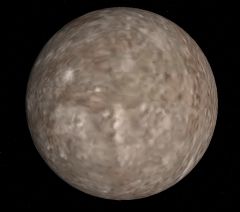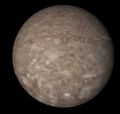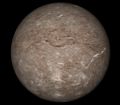Difference between revisions of "Titania"
(Added gallery image.) |
(Added image.) |
||
| Line 62: | Line 62: | ||
Titania021012.jpg|<center>Titania from uranus-neptune-moons.zip in Orbiter 2002</center> | Titania021012.jpg|<center>Titania from uranus-neptune-moons.zip in Orbiter 2002</center> | ||
Titania-orbiter2002p3.jpg|<center>Titania in Orbiter 2002P3</center> | Titania-orbiter2002p3.jpg|<center>Titania in Orbiter 2002P3</center> | ||
| + | Titania-Orbiter2003P2.jpg|<center>Titania in Orbiter 2003P2</center> | ||
Titania (moon) color, cropped.jpg|<center>Titania as seen by [[w:Voyager 2|Voyager 2]] in 1986</center> | Titania (moon) color, cropped.jpg|<center>Titania as seen by [[w:Voyager 2|Voyager 2]] in 1986</center> | ||
</gallery> | </gallery> | ||
Revision as of 03:19, 8 September 2024
Titania is the largest natural satellite of Uranus. Titania was discovered on January 11, 1787 by William Herschel.
The name Titania and the names of all four satellites of Uranus then known were suggested by William Herschel's son John Herschel in 1852 at the request of William Lassell, who had discovered Ariel and Umbriel the year before. Lassell had earlier endorsed Herschel's 1847 naming scheme for the seven then-known satellites of Saturn and had named his newly-discovered eighth satellite Hyperion in accordance with Herschel's naming scheme in 1848.
All of the moons of Uranus are named for characters from Shakespeare or Alexander Pope. Titania was named after Titania, the Queen of the Faeries in A Midsummer Night's Dream.
Titania in Orbiter
Titania was first introduced in Orbiter with the add-on uranus-neptune-moons.zip in October 2002.
| Add-on | Source | Version | Author | Type | Release Date | Compatibility | Wiki article |
|---|---|---|---|---|---|---|---|
| Orbiter 2003-P2 | O-F Resources | 031217 | martins | Orbiter Download | 17 December 2003 | Orbiter 2003-P2 | |
| Orbiter 2003-P1 | O-F Resources | 031105 | martins | Orbiter Download | 5 November 2003 | ||
| Uranus / Neptune Moons Addon | AVSIM | Robert Stettner (Foxtrot) | Scenery | 12 October 2002 | |||
Titania as seen by Voyager 2 in 1986
| Uranus's natural satellites |
|---|
| Named Satellites:
Ariel | Belinda | Bianca | Caliban | Cordelia | Cressida | Cupid | Desdemona | Ferdinand | Francisco | Juliet | Mab | Margaret | Miranda | Oberon | Ophelia | Perdita | Portia | Prospero | Puck | Rosalind | Setebos | Stephano | Sycorax | Titania | Trinculo | Umbriel Numbered Satellites: |
| See also: Pronunciation key | rings of Uranus |
| edit The Solar System | |
|---|---|
| Central star |
Sun (Sol) |
| Planets |
Mercury - Venus - Earth - Mars - Jupiter - Saturn - Uranus - Neptune |
| Natural satellites |
Moon - Phobos - Deimos - Io - Europa - Ganymede - Titan - more... |
| Add-ons |
Planets - Dwarf Planets - Small objects - Natural satellites - Alternative star systems |
 | This natural satellite related article is a stub. You can help Orbiterwiki by expanding it.
|




